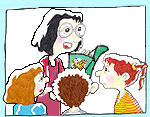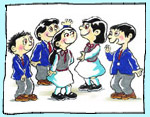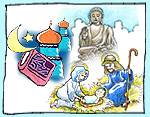| Overview |
Stories are texts about events which are significant in some way, as well as about the characters who take part in the events. The characters and events in a story can be real or imagined.
 |
We tell stories to entertain
people and to capture their interest. A storyteller captures people's interest by making them care
about the events and characters in the story, and about how things turn out
in the end. In order to do this storytellers
use language which affects our senses and our emotions. The language of an entertaining story
can make us feel happy, sad, frightened, excited, angry, calm,
peaceful or enthusiastic. It can build suspense and
excitement, puzzle and intrigue us, shock and surprise us, or
reassure us and make us laugh.
Storytellers want us to respond to the characters and events. Our response might be emotional (we start to care about what happens to the characters) or thoughtful (we learn something useful about our own lives). By choosing events and characters which are relevant to us and by making us feel that the events are significant, storytellers help us to interpret and make sense of events which happen in our own lives. |
 |
When students listen to, read, tell or write stories, they do the following things with language:
| build a story world | |
| create characters | |
| plot and sequence past events | |
| locate events in time and place | |
|
|
tell why and how things happen |
|
|
quote and report thoughts and feelings |
|
|
quote and report what people say |
|
|
build atmosphere and suspense |
|
|
give the story a message |
| Stories are found everywhere. When
we have conversations, we often tell stories to each other in order to make
the conversation more entertaining. Older people often tell younger
people stories in order to teach them about how to live their lives. Many
of these stories are passed down from one generation to the next, eg traditional
tales, religious stories or fables.
English literature is made up of many different types of stories. Novels, short stories, plays, operas and poems tell stories. Adults also often tell or read stories to children. In children's storybooks the stories are often told in pictures as well as in words. We can read stories in books, newspapers, magazines and comics. The films and dramas of popular culture
that we watch at the cinema or on the television are also stories, as are
radio dramas. Stories also form the basis of many popular video and
CD-ROM interactive games and activities. And advertisers
use stories to make us believe in the significance of the events in which
their products are involved and to make us care about the people who use
their products. |
|||
 |
|
|
 |
These pages will explore the language of traditional stories, fables and narratives in some detail. They will also provide examples of anecdotes, news stories and stories which set an example.
You will also find answers to the following questions:
| How are traditional stories, fables and narratives structured? | |
| What are the typical grammatical features of traditional stories, fables and narratives? | |
| How can I use traditional stories, fables and narratives in the classroom? |
We have provided you with several examples of particular descriptions. You will find these by clicking on Examples in the menu on the left.
|
||
To give us feedback about this section, click here or on the Comment button at the top of the screen.
If you have any questions about this section, visit the Language Corner.
If you have any questions or suggestions about how to teach this section, send a message to the Teaching Corner.